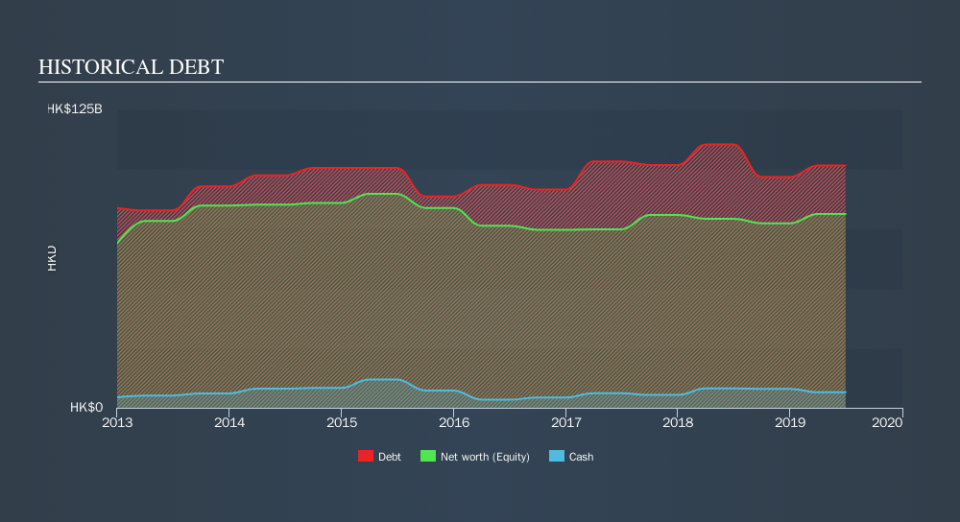Does China Resources Power Holdings (HKG:836) Have A Healthy Balance Sheet?

The external fund manager backed by Berkshire Hathaway's Charlie Munger, Li Lu, makes no bones about it when he says 'The biggest investment risk is not the volatility of prices, but whether you will suffer a permanent loss of capital. So it might be obvious that you need to consider debt, when you think about how risky any given stock is, because too much debt can sink a company. As with many other companies China Resources Power Holdings Company Limited (HKG:836) makes use of debt. But is this debt a concern to shareholders?
When Is Debt A Problem?
Debt assists a business until the business has trouble paying it off, either with new capital or with free cash flow. Ultimately, if the company can't fulfill its legal obligations to repay debt, shareholders could walk away with nothing. However, a more common (but still painful) scenario is that it has to raise new equity capital at a low price, thus permanently diluting shareholders. By replacing dilution, though, debt can be an extremely good tool for businesses that need capital to invest in growth at high rates of return. The first step when considering a company's debt levels is to consider its cash and debt together.
See our latest analysis for China Resources Power Holdings
How Much Debt Does China Resources Power Holdings Carry?
As you can see below, China Resources Power Holdings had HK$101.5b of debt at June 2019, down from HK$110.3b a year prior. However, it also had HK$6.50b in cash, and so its net debt is HK$95.0b.
A Look At China Resources Power Holdings's Liabilities
The latest balance sheet data shows that China Resources Power Holdings had liabilities of HK$63.8b due within a year, and liabilities of HK$70.4b falling due after that. Offsetting these obligations, it had cash of HK$6.50b as well as receivables valued at HK$20.3b due within 12 months. So its liabilities total HK$107.5b more than the combination of its cash and short-term receivables.
The deficiency here weighs heavily on the HK$44.5b company itself, as if a child were struggling under the weight of an enormous back-pack full of books, his sports gear, and a trumpet." So we'd watch its balance sheet closely, without a doubt After all, China Resources Power Holdings would likely require a major re-capitalisation if it had to pay its creditors today.
We measure a company's debt load relative to its earnings power by looking at its net debt divided by its earnings before interest, tax, depreciation, and amortization (EBITDA) and by calculating how easily its earnings before interest and tax (EBIT) cover its interest expense (interest cover). Thus we consider debt relative to earnings both with and without depreciation and amortization expenses.
China Resources Power Holdings's debt is 4.0 times its EBITDA, and its EBIT cover its interest expense 3.9 times over. Taken together this implies that, while we wouldn't want to see debt levels rise, we think it can handle its current leverage. Investors should also be troubled by the fact that China Resources Power Holdings saw its EBIT drop by 13% over the last twelve months. If things keep going like that, handling the debt will about as easy as bundling an angry house cat into its travel box. There's no doubt that we learn most about debt from the balance sheet. But ultimately the future profitability of the business will decide if China Resources Power Holdings can strengthen its balance sheet over time. So if you're focused on the future you can check out this free report showing analyst profit forecasts.
Finally, a company can only pay off debt with cold hard cash, not accounting profits. So the logical step is to look at the proportion of that EBIT that is matched by actual free cash flow. Over the last three years, China Resources Power Holdings reported free cash flow worth 2.3% of its EBIT, which is really quite low. For us, cash conversion that low sparks a little paranoia about is ability to extinguish debt.
Our View
We'd go so far as to say China Resources Power Holdings's level of total liabilities was disappointing. And furthermore, its net debt to EBITDA also fails to instill confidence. After considering the datapoints discussed, we think China Resources Power Holdings has too much debt. That sort of riskiness is ok for some, but it certainly doesn't float our boat. Given the risks around China Resources Power Holdings's use of debt, the sensible thing to do is to check if insiders have been unloading the stock.
At the end of the day, it's often better to focus on companies that are free from net debt. You can access our special list of such companies (all with a track record of profit growth). It's free.
We aim to bring you long-term focused research analysis driven by fundamental data. Note that our analysis may not factor in the latest price-sensitive company announcements or qualitative material.
If you spot an error that warrants correction, please contact the editor at editorial-team@simplywallst.com. This article by Simply Wall St is general in nature. It does not constitute a recommendation to buy or sell any stock, and does not take account of your objectives, or your financial situation. Simply Wall St has no position in the stocks mentioned. Thank you for reading.

